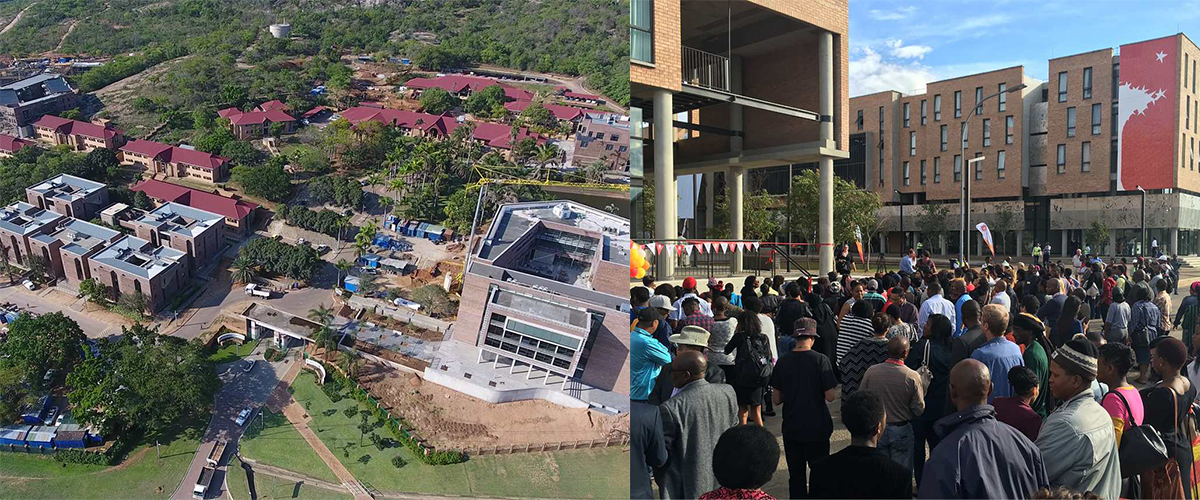
New Universities Case Study Close Out Report
Project overview
Towards the end of 2011, the University of the Witwatersrand (Wits) was approached by the Department of Higher Education and Training (DHET) to provide specialised delivery capacity for the implementation of government’s decision to establish new universities in the Mpumalanga and Northern Cape provinces of South Africa. A memorandum of agreement (MOA) between Wits and DHET established the New Universities Project Management Team (NUPMT) to direct academic and institutional planning as well as the planning, design, construction and handover of infrastructure for the first phase of both universities.
This close out report of the NUPMT provides a succinct anatomy of the project including the delivery of higher education infrastructure facilities, from the adoption of the business case to the handover and close out of the first delivery phase. The report covers the development of the University of Mpumalanga and the Sol Plaatje University from October 2011, when the NUPMT commenced with identification of suitable sites, to July 2017, when the facilities delivered for the 2016 academic year were closed out and the NUPMT was demobilised.
This report commences with the context and drivers within which these two new universities were delivered. It outlines the progressive expansion of the NUPMT’s responsibilities over time and describes:
- project governance arrangements that were put in place to inform and shape delivery;
- the academic and institutional development of the two new institutions;
- the land assembly process;
- the processes for obtaining of the necessary budget and planning approvals; as well as the approach taken to enable enrolment of the first cohort of students for the first academic year at the start of 2014.
This report also provides an overview of some of the innovations adopted by the NUPMT in delivering the required facilities, namely
- the use of spatial development frameworks to provide form, content and meaning to the
- physical requirements for these two institutions;
- implementation of an architectural design competition to procure a high standard of architectural quality in order to create iconic and inspirational architecture;
- a procurement strategy that was adapted to ensure that procurement outcomes are aligned with project and procurement objectives; and
- a design philosophy which translated into design briefs for the professional teams.
The report also describes the facilities that were delivered. It provides a management review of project performance, which links expenditure to phases of development and reviews procurement outcomes in terms of project objectives and value for money. It concludes with the handover of a live project to the institutions that were established though the project and that are responsible for its effective functioning and continued expansion and growth.
Downloads
- Close Out Report outline
- Close Out Report Chapters 1 to 15
- Chapter 1 Introduction and overview | Chapter 1 with annexures
- Chapter 2 Context and drivers | Chapter 2 with annexures
- Chapter 3 Project inception and evolution | Chapter 3 annexures 3.1 / 3.2 / 3.3 / 3.4 / 3.5 / 3.6 / 3.7 / 3.8 / 3.9 / 3.10
- Chapter 4 Governance | Chapter 4 with annexures
- Chapter 5 Academic and institutional development | Chapter 5 with annexures
- Chapter 6 Land assembly, feasibility and early implementation | Chapter 6 annexures 6.1 to 6.3 / 6.4 / 6.5 / 6.6 to 6.9 / 6.10 to 6.18 / 6.19 to 6.22
- Chapter 7 Spatial Development Framework | Chapter 7 with annexures
- Chapter 8 Architectural design competition | Chapter 8 with annexures
- Chapter 9 Procurement strategy | Chapter 9 with annexures
- Chapter 10 Design development and Project Delivery Goals | Chapter 10 annexures 10.1 / 10.2a / 10.2b / 10.3a / 10.3b / 10.4 / 10.5 / 10.6 / 10.7 / 10.8
- Chapter 11 Client focus on development | Chapter 11 with annexures
- Chapter 12 Architecture and buildings at Sol Plaatje | Chapter 12 with annexures
- Chapter 13 Architecture and buildings at University of Mpumalanga | Chapter 13 with annexures
- Chapter 14 Review of expenditure and value for money | Chapter 14 with annexures
- Chapter 15 Hand over and close out | Chapter 15 with annexures

